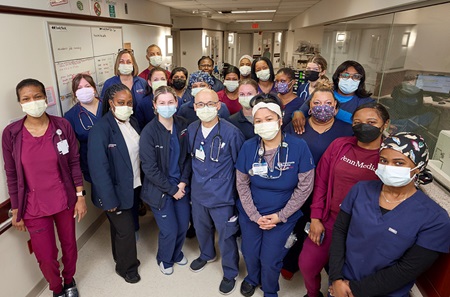 The Pennsylvania Patient Safety Authority held its annual I AM Patient Safety Awards, recognizing three projects led by PAH staff and celebrating their efforts for creating a more secure and safe clinical setting.
The Pennsylvania Patient Safety Authority held its annual I AM Patient Safety Awards, recognizing three projects led by PAH staff and celebrating their efforts for creating a more secure and safe clinical setting.
Medication Management
If an inpatient was prescribed liquid methadone – a medication used to manage withdrawal symptoms from substance use disorder – the PAH inpatient pharmacy would come up to the unit to deliver the medication close to the ordered time, directly to the nurse caring for the patient. Sometimes, nurses would have to call the pharmacy and wait for the exact dose to be delivered. Many nurses wouldn’t be able to administer the medication immediately, as they were taking care of their other patients, leaving them challenged with how to safely store the syringe in the interim.
These concerns were discussed during daily safety huddles on 5 Cathcart/Schiedt, attended by all members of the unit. Rather than having to wait and find safe storing areas for medication deliveries, a team of the unit’s nurses worked with the pharmacy to implement methadone dispensing in pre-existing technology across the hospital, earning them an award in the Safety Story category.
The team reprogrammed the unit’s Omnicell, a secured medication dispensing cabinet, to include methadone in its system. A nurse would then be able to log in and find their patient’s dosage. Rather than having the exact dose delivered by the pharmacy, the methadone is now always readily available for when a nurse needs to administer the liquid.
“It’s empowering for our staff to be recognized for this safety improvement,” said nurse manager Angela Ross, MSN, RN, OCN. “It’s motivated them to continue elevating our safety protocols and how we can make things even better for patients.”
Protocols for Patients at Risk
A group of employees from the Emergency Department, Behavioral Health, Social Work, and Medical-Surgical, among other departments, were recognized as a runner-up in the Safety Story category for creating a brochure centered around care and communication for patients at risk (PAR) for suicide, self-harm, or harm to others, or for opioid or substance use disorders or elopement (leaving a hospital unsupervised and undetected). The PAR workgroup additionally won a Josie King Hero Award for this initiative in September.
Through root cause analyses, the workgroup found that a major factor contributing to patient elopement at hospitals was a gap in communication at the time of handoff of care from one caregiver to another. Displayed on each unit’s safety review board, the brochures can be retrieved by any staff in need of PAR guidance as they transition from day to night shifts. Staff can follow a checklist of protocols in caring for PAR, such as identifying a PAR with a gray Kardex – an assessment tool containing details about a patient’s care that an employee will give to a colleague following their shift. The gray, rather than the typically white handoff tool, alerts staff about PAR on their unit.
In addition, the brochure includes the best practices for creating a safe environment in a patient room, such as identifying and removing any ligature risks – anything with a cord, rope, or other material that pose a risk of strangulation.
Pre-Procedure Bedside Time-Out
Before a patient enters the operating room (OR), their care team ensures they sign all the proper consent forms, which are then marked as complete in the electronic medical record. However, there are instances when a member of the team may identify a discrepancy in the consent process, such as noticing an incorrect form signed, causing a disruption for the surgical team. To improve the consent form process, members of PAH’s Perianesthesia, OR, and Anesthesia joined forces to implement a new series of safety checks before a patient undergoes a procedure.
Pre-Procedure Bedside Time-Out, which won a Patient Safety Award in the Time-Outs category, allows a provider from each department involved in the procedure to convene in a huddle before surgery. Together, they’ll verify that each consent form is correct, making sure it includes the right patient, site of surgery, and laterality (left or right side of body). The care team also meets with the patient at the bedside, verifying their name, date of birth, and the procedure they will be receiving, making them a member of the team as well. Since the project’s launch in February 2020, the team has observed a reduction in safety events and has received positive feedback from colleagues.
“I love when I see the Safety Net reports and there’s a note saying an issue was quickly identified and resolved due to Pre-Procedure Bedside Time-Out,” said Margaret Vance, MSN, RN, CNOR, a clinical nurse education specialist. “It’s a great attestation to the work that we do.”
“Our goal is to give the highest quality care with the best experience, and this project really encompasses that,” said Sunilka Thompson, MSN, RN, CPXP, associate clinical director of Perianesthesia and Procedural Areas. “It’s rewarding that our team is being recognized for this project that’s having a significant impact on patient care delivery.”